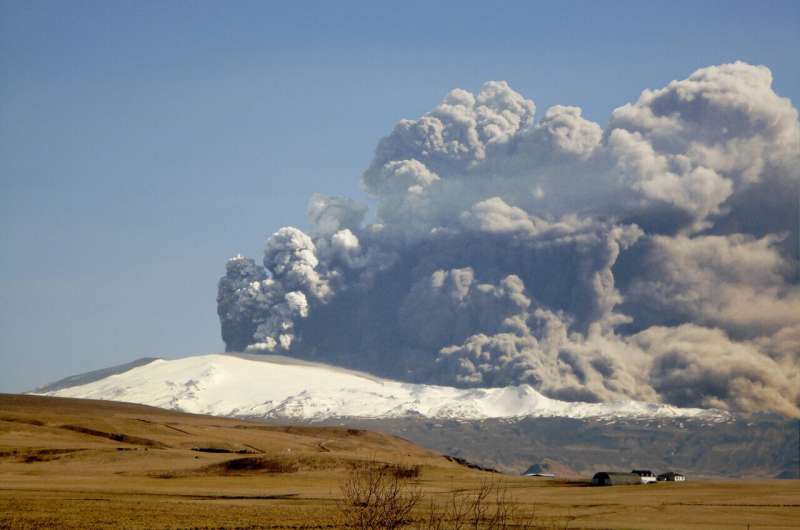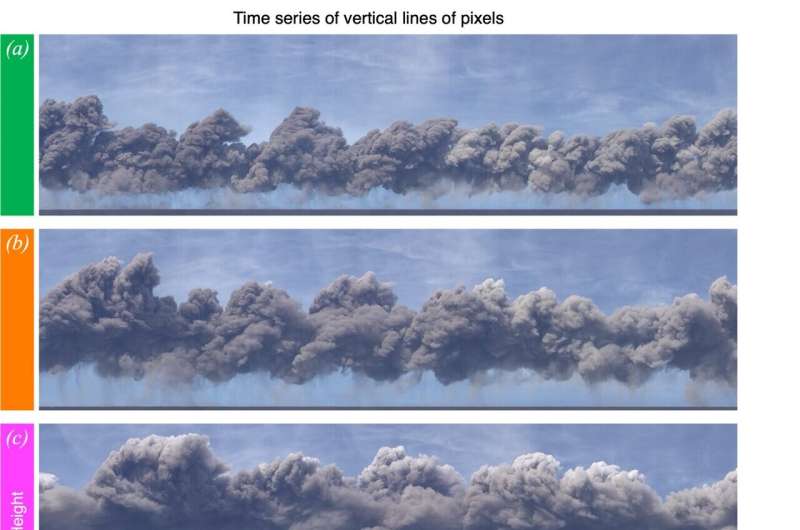This article has been reviewed according to Science X's editorial process and policies. Editors have highlighted the following attributes while ensuring the content's credibility:
fact-checked
peer-reviewed publication
trusted source
proofread
Study shows video analysis of Iceland 2010 eruption could improve volcanic ash forecasts for aviation safety

Video footage of Iceland's 2010 Eyjafjallajökull eruption is providing researchers from the University of Cambridge with rare, up-close observations of volcanic ash clouds—information that could help better forecast how far explosive eruptions disperse their hazardous ash particles.
When Eyjafjallajökull erupted in 2010, it ejected roughly 250 million tonnes of volcanic ash into the atmosphere: much of which was blown over Europe and into flight paths. With planes grounded, millions of air passengers were left stranded.
Forecasts of how ash will spread in the aftermath of an explosive eruption can help reduce impacts to aviation by informing decisions to shut down areas of airspace. But these forecasts require knowledge of what is happening at the volcano, information that often can't be obtained directly and must instead be estimated.
In the new study, the researchers split a 17-minute film into time segments to understand how the Eyjafjallajökull ash cloud grew upwards and outwards as the eruption ensued.
"No one has previously observed the shape and speed of wind-blown ash clouds directly," said Professor Andy Woods, lead author of the study from Cambridge's Department of Earth Sciences and Institute for Energy and Environmental Flows. Their new video analysis method was reported in Communications Earth and Environment.
By comparing characteristics of the ash cloud, such as its shape and speed, at time intervals through the video, the researchers were able to calculate the amount of ash spewed from the volcano.

That rate of ash flow, called eruption rate, is an important metric for forecasting ash cloud extent, said Woods. He added, "The eruption rate determines how much ash goes up into the atmosphere, how high the ash cloud will go, how long the plume will stay buoyant, how quickly the ash will start falling to the ground and the area over which ash will land."
Generally, the higher the ash plume, the wider the ash will be dispersed, and the smaller the ash particles are, the longer they stay buoyant. This dispersal can also depend on weather conditions, particularly the wind direction.
Volcanoes across the world are increasingly monitored via video, using webcams or high-resolution cameras. Woods thinks that, if high frame rate video observations can be accessed during an eruption, then this real-time information could be fed into ash cloud forecasts that more realistically reflect changing eruption conditions.
During the 17-minute footage of the Eyjafjallajökull eruption, the researchers observed that the eruption rate dropped by about half. "It's amazing that you can learn eruption rate from a video. That's something that we've previously only been able to calculate after an eruption has happened," said Woods. "It's important to know the changing eruption rate because that could impact the ash cloud dispersal downwind."
It's usually challenging for volcanologists to take continuous measurements of ash clouds while an eruption is happening. "Instead, much of our understanding of how ash clouds spread in the atmosphere is based on scaled-down lab models," said Dr. Nicola Mingotti, a researcher in Woods' group and co-author of this study. These experiments are performed in water tanks, by releasing particle-laden or dyed saline solutions and analyzing footage of the plume as it dissipates.
Woods and his collaborators have been running lab experiments like these for several years, most recently trying to understand how eruption plumes are dragged along by the wind. But it's a big bonus to have video measurements from a real eruption, said Woods, and the real observations agree closely with what they've been observing in the lab.
The researchers said, "Demonstrating our lab experiments are realistic is really important, both for making sure we understand how ash plumes work and that we forecast their movements effectively."
More information: Nicola Mingotti et al, Video-based measurements of the entrainment, speed and mass flux in a wind-blown eruption column, Communications Earth & Environment (2024). DOI: 10.1038/s43247-024-01402-x
Journal information: Communications Earth & Environment
Provided by University of Cambridge





















